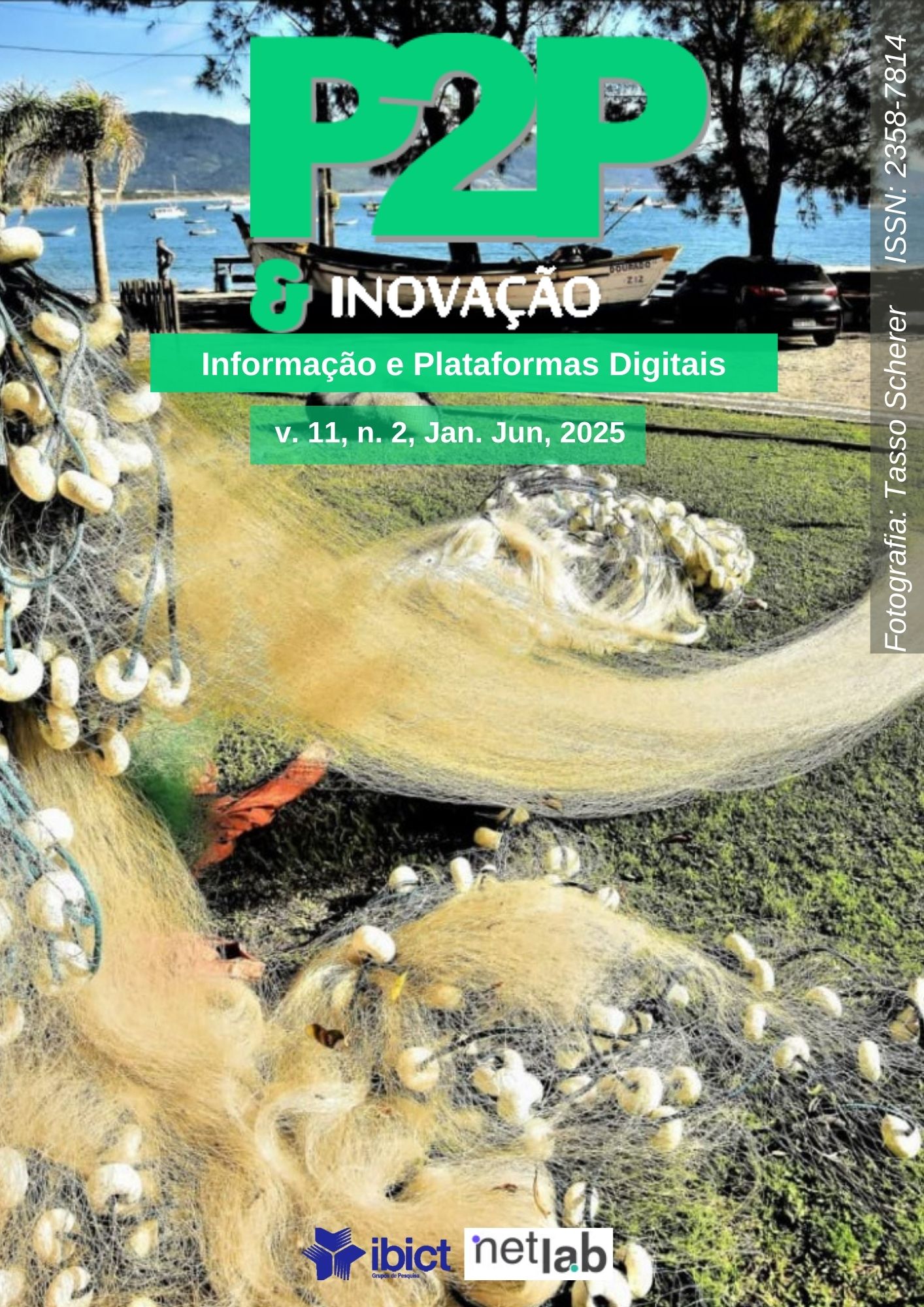COEVOLUCIÓN: TENDENCIAS E INFLUENCIAS DE MAPEO EN DINÁMICAS E INNOVACIONES SOCIO-NATURALES
mapeando tendências e influências nas dinâmicas sócio-naturais e inovações
DOI:
https://doi.org/10.21728/p2p.2025v11n2e-7450Palabras clave:
camuflaje, Polinización asistida, Hipótesis de la reina rojaResumen
La coevolución es un fenómeno fascinante que se manifiesta de varias maneras en el mundo natural, incluida la simbiosis, la polinización, el camuflaje, la depredación, la carrera armamentista y la competencia. Estos procesos ilustran la compleja red de interacciones que dan forma a la biodiversidad y la dinámica de los ecosistemas. Cuando se aplica a la relación entre la sociedad y la tecnología, esta idea captura la esencia de cómo las capacidades biológicas e innovaciones se forman mutuamente. El objetivo de este trabajo era llevar a cabo una revisión de la literatura sobre la coevolución biológica y su influencia en la dinámica e innovaciones socionacionales. La encuesta de datos se realizó de 2004 a 2024 en la Web of Science and Scopus Database. La investigación en coevolución, al explorar las interacciones dinámicas entre los organismos (humanos y no humanos) y su entorno, reveló una fuerza impulsora tanto en la naturaleza como en la innovación tecnológica. Al mapear las tendencias e influencias de la dinámica e innovaciones socionacionales, estas relaciones complejas dan forma a la biodiversidad, la resiliencia de los ecosistemas y la sociedad.
Descargas
Referencias
AHMED K. Brain-Inspired Spiking Neural Networks [Internet]. Biomimetics. IntechOpen; 2021. Available from: http://dx.doi.org/10.5772/intechopen.93435
ANDREAZZI, C. S.; ASTEGIANO, J.; GUIMARÃES, P. R. Coevolution by different functional mechanisms modulates the structure and dynamics of antagonistic and mutualistic networks. Oikos, v. 129, n. 2, p. 224–237, 1 fev. 2020. DOI: 10.1086/692110
ANDREAZZI, C. S.; THOMPSON, J. N.; GUIMARÃES, P. R. Network structure and selection asymmetry drive coevolution in species-rich antagonistic interactions. American Naturalist, v. 190, n. 1, p. 99–115, 2017. DOI: 10.1086/692110
BURGER, N.; FRANCOIS, V.; NICOLIS, V. F.; BOTHA, A. Host-specific co-evolution likely driven by diet in Buchnera aphidicola. BMC genomics, v. 25, n. 1, p. 153, 2024.
CASE, T. J. et al. The community context of species’ borders: Ecological and evolutionary perspectives. Oikos, jan. 2005. DOI: 10.1111/j.0030-1299.2005.13148.x
CRUMIÈRE, A. J. J. et al. Escalation and morphological constraints of antagonistic armaments in water striders. Frontiers in Ecology and Evolution, v. 7, n. jun, 2019. DOI: 10.3389/fevo.2019.00215
DCR - Virginia Department of Conservation and Recreation. Native and Non-native Invasive Plants.https://www.dcr.virginia.gov/natural-heritage/native-vs-aliens, 2024.
DE CASTRO, É. C. P. et al. The arms race between heliconiine butterflies and Passiflora plants – new insights on an ancient subject. Biological Reviews, v. 93, n. 1, p. 555–573, 1 fev. 2018. DOI: 10.1086/692110
DECAESTECKER, E. et al. Host-parasite “Red Queen” dynamics archived in pond sediment. Nature, v. 450, n. 7171, p. 870–873, 6 dez. 2007. DOI: 10.1038/nature06291
DINIZ, M. C., MARTINS, M. G., XAVIER, K. V. M., SILVA, M. A. A. DA, & SANTOS, E. DE A.Crise Global Coronavírus: monitoramento e impactos. Cadernos de Prospecção, 13(2), 359. 2020. https://doi.org/10.9771/cp.v13i2.35937
DIXIT, T. A synthesis of coevolution across levels of biological organization. Evolution, v. 78, n. 2, p. 211-220, 1 fev. 2024. DOI: 10.1093/evolut/qpad082
DODDS, P. N. et al. Direct protein interaction underlies gene-for-gene specificity and coevolution of the flax resistance genes and flax rust avirulence genes. PNAS, v. 103, n. 23, p. 8888-8893, jun. 2006. DOI: 10.1073/pnas.0602577103
É, G. DO N. , PEDUTI, G. P., CARVALHO, A. M. L. DE, RABELO, A. DOS S., & DINIZ, M. C. Bioimpressão 3D de Tecidos e Órgãos: uma prospecção tecnológica. Cadernos de Prospecção, 13(5), 1383. 2020. https://doi.org/10.9771/cp.v13i5.33571
EBERT, D. Host-parasite coevolution: Insights from the Daphnia-parasite model system. Current Opinion in Microbiology, v. 11, p. 290-301, jun. 2008. DOI: 10.1016/j.mib.2008.05.012
ERNST, M. et al. Assessing specialized metabolite diversity in the cosmopolitan plant genus Euphorbia l. Frontiers in Plant Science, v. 10, 31 maio 2019. DOI: 10.3389/fpls.2019.00846
FEENEY, W. E.; WELBERGEN, J. A.; LANGMORE, N. E. Advances in the study of coevolution between avian brood parasites and their hosts. Annual Review of Ecology, Evolution, and Systematics, v. 45, p. 227–246, 23 nov. 2014. DOI: 10.1146/annurev-ecolsys-120213-091603
FORTUNA, M. A. et al. Coevolutionary dynamics shape the structure of bacteria-phage infection networks. Evolution, v. 73, n. 5, p. 1001–1011, 1 maio 2019. DOI: 10.1111/evo.13731
GALLAGHER, J.E., OUGHTON, E.J. Assessing thermal imagery integration into object detection methods on air-based collection platforms. Sci Rep 13, 8491 (2023). https://doi.org/10.1038/s41598-023-34791-8
GOSTINSKI, L. F., COSTA, H. D., FIRMO, W. DA C. A., MENDES, H. B. R., CRUZ, G. B. V., & ALBUQUERQUE, P. M. C. DE. PROSPECÇÃO TECNOLÓGICA: O USO DE DISPOSITIVOS DE GEORREFERENCIAMENTO PARA ANÁLISE DA DISTRIBUIÇÃO E COMPORTAMENTO DE ABELHAS SOCIAIS. Cadernos de Prospecção, 9(1), 63.2016 https://doi.org/10.9771/s.cprosp.2016.009.008
GÓMEZ, P.; BUCKLING, A. Bacteria-Phage Antagonistic Coevolution in Soil. Science, v. 332, n. 6025, p. 106-109, abr 2011. DOI: 10.1126/science.1198767
GRIM, Tomáš. Perspectives and debates: Mimicry, signalling and co‐evolution (Commentary on Wolfgang Wickler–Understanding Mimicry–With special reference to vocal mimicry). Ethology, v. 119, n. 4, p. 270-277, 2013.
HARMON, L. J. et al. Detecting the macroevolutionary signal of species interactions. Journal of Evolutionary Biology, v. 32, p. 769-782, abr 2019. DOI: 10.1111/jeb.13477
HUANG, Jin-Nan et al. Salticid predation as one potential driving force of ant mimicry in jumping spiders. Proceedings of the Royal Society B: Biological Sciences, v. 278, n. 1710, p. 1356-1364, 2011.
JAMIE, G.A. Signals, cues and the nature of mimicry. Proceedings of the Royal Society B: Biological Sciences, v. 284, n. 1849, p. 20162080, 2017.
JOKELA, J.; DYBDAHL, M. F.; LIVELY, C. M. The maintenance of sex, clonal dynamics, and host-parasite coevolution in a mixed population of sexual and asexual snails. American Naturalist, v. 174, n. SUPPL. 1, jul. 2009. DOI: 10.1086/599080
KOSKELLA, B.; LIVELY, C. M. Advice of the rose: Experimental coevolution of a trematode parasite and its snail host. Evolution, v. 61, n. 1, p. 152–159, jan. 2007. DOI: 10.1111/j.1558-5646.2007.00012.x
LIVELY, C. M. Parasite virulence, host life history, and the costs and benefits of sex. Ecology, v. 91, n. 1, p. 3–6, jan. 2010. DOI: 10.1890/09-1158.1
LU, H. L.; ST. LEGER, R. J. Insect Immunity to Entomopathogenic Fungi. Advances in Genetics, v. 94, p. 251–285, 2016. DOI: 10.1016/bs.adgen.2015.11.002
MARK, C. J., O'HANLON, J.C., HOLWELL, G.I. Camouflage in lichen moths: Field predation experiments and avian vision modelling demonstrate the importance of wing pattern elements and background for survival. Journal of Animal Ecology, v. 91, n. 12, p. 2358-2369, 2022.
MARTÍN, A.A., et al. Google Scholar, Web of Science, and Scopus: a systematic comparison of citations in 252 subject categories. Journal of Informetrics [online]. 2018, vol. 12, no. 4, pp. 1160-1177 [viewed 27 November 2019]. DOI: 10.1016/J.JOI.2018.09.002. Available from: https://www.sciencedirect.com/science/article/abs/pii/S1751157718303249
MITHÖFER, A.; BOLAND, W. Plant defense against herbivores: Chemical aspects. Annual Review of Plant Biology, v. 63, p. 431-450, jun. 2012. DOI: 10.1146/annurev-arplant-042110-103854
MOREIRA, P. S. C.; GUIMARÃES, A. J. R.; TSUNODA, D. F. Qual ferramenta bibliométrica escolher? um estudo comparativo entre softwares. P2P e Inovação, v. 6, p. 140-158, 2020.
MORANEUS. Evolution: Not Just a Theory, But a Problem-Solving Tool. https://medium.com/@moraneus/evolution-not-just-a-theory-but-a-problem-solving-tool-0e5884f68bd8, 2024.
NAIR, R. et al. A coevolução bacteriana predador-presa acelera a evolução do genoma e seleciona as defesas das presas associadas à virulência. Comunicações da natureza , v. 10, n. 1, pág. 4301, 2019.
NUISMER, S. L.; HARMON, L. J. Predicting rates of interspecific interaction from phylogenetic trees. Ecology Letters, v. 18, n. 1, p. 17–27, 1 jan. 2015. DOI: 10.1111/ele.12384
NUISMER, S. L.; WEEK, B. Approximate Bayesian estimation of coevolutionary arms races. PLoS Computational Biology, v. 15, n. 4, 2019. DOI: 10.1371/journal.pcbi.1006988
OLLERTON, J. et al. The diversity and evolution of pollination systems in large plant clades: Apocynaceae as a case study. Annals of Botany, v. 123, n. 2, p. 311-325, 2019.
OTTE, P.J. et al. Snow cover‐related camouflage mismatch increases detection by predators. Journal of Experimental Zoology Part A: Ecological and Integrative Physiology, 2024.
PARKER, G. A. Sexual conflict over mating and fertilization: An overview. Philosophical Transactions of the Royal Society B, v. 361, p. 235-259, jan. 2006. DOI: 10.1098/rstb.2005.1785
PATERSON, S. et al. Antagonistic coevolution accelerates molecular evolution. Nature, v. 464, n. 7286, p. 275–278, 11 mar. 2010. DOI: 10.1038/nature08798
PEMBURY S et al. Camouflage in predators. Biological Reviews, v. 95, n. 5, p. 1325-1340, 2020.
PIRES, E. A., FERREIRA, M. A., VIEIRA, R. B., BARBOSA, C. A., & SANTOS, F. L. PERFIL DOS DOCUMENTOS DE PATENTE REFERENTES A TECNOLOGIAS E PRODUTOS PROBIÓTICOS, PREBIÓTICOS E SIMBIÓTICOS NA AMÉRICA LATINA. Cadernos de Prospecção, 8(1), 142. 2015. https://doi.org/10.9771/s.cprosp.2015.001.016
REYNOLDS, C. Coevolution of Camouflage. In: Artificial Life Conference Proceedings 35. One Rogers Street, Cambridge, MA 02142-1209, USA journals-info@ mit. edu: MIT Press, 2023. p. 11.
RODGER, J. G. et al. Widespread vulnerability of flowering plant seed production to pollinator declines. Science advances, v. 7, n. 42, p. eabd3524, 2021.
SALAZAR, D. et al. Origin and maintenance of chemical diversity in a species-rich tropical tree lineage. Nature Ecology and Evolution, v. 2, n. 6, p. 983–990, 1 jun. 2018. DOI: 10.1038/s41559-018-0552-0
SANTOS, S. C. DOS, CASTRO, D. C. M. DE, ASSUNÇÃO, P. S. DE, SANTOS, T. L. DOS, & QUINTELLA, C. M. Mapeamento Tecnológico de Processos Microbianos Aplicados na Biorremediação de Metais Pesados. Cadernos de Prospecção, 11(5), 1740. 2018. https://doi.org/10.9771/cp.v11i5.25240
SANTOS, A. F. DE J., & HANNA, S. A. PROSPECÇÃO TECNOLÓGICA DE PATENTES NA PRODUÇÃO DE BIOINOCULANTES E BIOFERTILIZANTES. Cadernos de Prospecção, 10(2), 300. 2017 https://doi.org/10.9771/cp.v10i2.20719
SAUQUET, H.; MAGALLÓN, S. Key questions and challenges in angiosperm macroevolution. New Phytologist, v. 219, n. 4, p. 1170-1187, 2018.
SCHENK, H. J. Root competition: Beyond resource depletion. Journal of Ecology, jul. 2006. DOI: 10.1111/j.1365-2745.2006.01124.x
SHERRATT, T.N. The evolution of Müllerian mimicry. Naturwissenschaften, v. 95, n. 8, p. 681-695, 2008.
SIEDENTOP, B. et al. My host’s enemy is my enemy: plasmids carrying CRISPR-Cas as a defence against phages. Proceedings of the Royal Society B: Biological Sciences, v. 291, n. 2015, 24 jan. 2024. DOI: 10.1098/rspb.2023.2449
STEPHENS, R. E.; GALLAGHER, R. V.; DUN, L.; CORNWELL, W.; SAUQUET, H. Insect pollination for most of angiosperm evolutionary history. New Phytologist, v. 240, n. 2, p. 880-891, 2023.
USAMENTIAGA R, VENEGAS P, GUEREDIAGA J, VEGA L, MOLLEDA J, BULNES F G. Infrared thermography for temperature measurement and non-destructive testing. Sensors (Basel). 2014 Jul 10;14(7):12305-48. doi: 10.3390/s140712305. PMID: 25014096; PMCID: PMC4168422.
VAN HOUTE, S. et al. The diversity-generating benefits of a prokaryotic adaptive immune system. Nature, v. 532, n. 7599, p. 385–388, 21 abr. 2016. DOI: 10.1038/nature17436
VAN HOUTE, S.; BUCKLING, A.; WESTRA, E. R. Evolutionary Ecology of Prokaryotic Immune Mechanisms. Microbiology and Molecular Biology Reviews, v. 80, n. 3, p. 745–763, set. 2016. DOI: 10.1128/mmbr.00011-16
VAN ECK N. J.; WALTMAN, L. Software Survey: VOSviewer, a Computer Program for Bibliometric Mapping. Scientometrics, v84, n.2: 523–38, 2010.
WANG, A. Y. et al. The nature of interspecific interactions and co-diversification patterns, as illustrated by the fig microcosm. New Phytologist, v. 224, n. 3, p. 1304–1315, 1 nov. 2019. DOI: 10.1111/nph.16
WANG, X. et al. Phenotypic plasticity plays an essential role in the confrontation between plants and herbivorous insects. CABI Agriculture and Bioscience, v. 4, n. 58, p. 1-12, 1 dez. 2023. DOI: 10.1186/s43170-023-00201-2
YODER, J. B.; NUISMER, S. L. When does coevolution promote diversification? American Naturalist, v. 176, n. 6, p. 802–817, dez. 2010. DOI: 10.1086/657048
ZHOU P, CHEN C, PATIL S, DONG S. Unveiling the therapeutic symphony of probiotics, prebiotics, and postbiotics in gut-immune harmony. Front Nutr. 2024 Feb 8;11:1355542. doi: 10.3389/fnut.2024.1355542. PMID: 38389798; PMCID: PMC10881654.
Descargas
Publicado
Número
Sección
Licencia
Derechos de autor 2025 Jonas Conduru Barros Neto, Geysa Oliveira Lima Machado, Thaís Correia Magalhães, Michely Correia Diniz

Esta obra está bajo una licencia internacional Creative Commons Atribución-NoComercial-CompartirIgual 4.0.
A revista é publicada sob a licença Creative Commons - Atribuição - Uso Não Comercial - Partilha nos Mesmos Termos 4.0 Internacional.
O trabalho publicado é considerado colaboração e, portanto, o autor não receberá qualquer remuneração para tal, bem como nada lhe será cobrado em troca para a publicação.
Os textos são de responsabilidade de seus autores.
É permitida a reprodução total ou parcial dos textos da revista, desde que citada a fonte.















